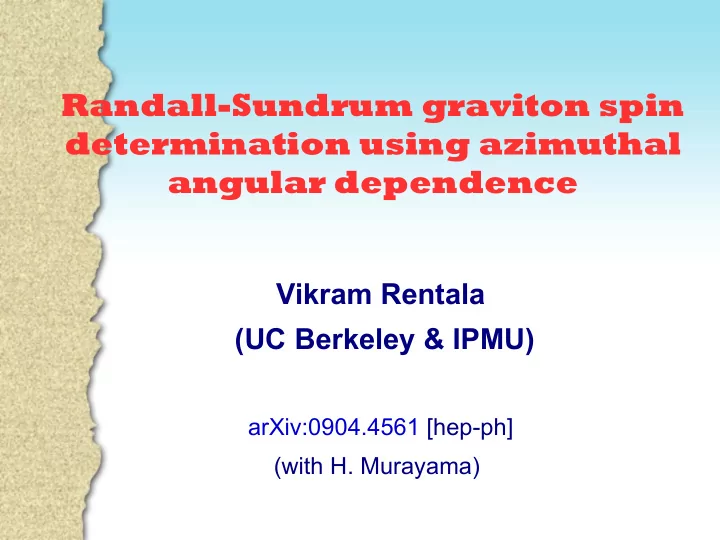

Randall-Sundrum graviton spin determination using azimuthal angular dependence Vikram Rentala (UC Berkeley & IPMU) arXiv:0904.4561 [hep-ph] (with H. Murayama)
Presentation Outline ● Using Quantum Interference of Helicity Amplitudes to measure spin ● Challenge of spin measurement at the LHC ● Application of this technique to the RS graviton case at the LHC
Why measure spin? UED: Spin-1/2 Susy: Spin-0
Collider Physics Angles
Model Independent Technique for Measuring Spins Back to Fundamentals Spin is a type of angular momentum ● i J . n φ U n ,φ = e Angular momentum generates rotations ● We can isolate spin from orbital angular momentum by considering the ● component of angular momentum in the direction of motion of a particle
Model Independent Technique for Measuring Spins Production plane provides a reference orientation ● Rotating the decay plane about the +z axis by an angle φ → action of this ● rotation on the matrix element of the decay must be equivalent to the action of rotation on the parent particle by φ . M. R. Buckley, H. Murayama, W. Klemm, V. Rentala (hep-ph/0711.0364)
Quantum Interference of Helicity States Vector Boson Spinor If multiple helicity states are produced this phase dependence is observable ● True within the validity of the narrow width approximation (“weakly coupled” ● physics) As a result of interference the differential cross-section develops a cos(n φ ) ● dependence, where n = h max -h min = 2s.
The Bottom Line dσ Scalar: dφ = A 0 dσ dφ = A 0 A 1 cos φ Spinor: dσ dφ = A 0 A 1 cos φ A 2 cos 2φ Vector boson: dσ dφ = A 0 A 1 cos φ A 2 cos 2φ A 3 cos 3φ A 4 cos 4φ Tensor (spin-2): Look for the highest cosine mode to determine the spin!* *(Can set a lower bound on the spin of a particle) This argument is based entirely on Quantum Mechanical principles, to ● actually compute the coefficients requires Feynman diagrams!
The Large Hadron Collider Applying this technique at the LHC ● Missing energy events are not reconstructible ● Odd modes disappear ● Have to adjust for detector cuts
Randall-Sundrum Graviton spin? ● RS case: Fully reconstructible! No missing energy. Spin measurement easier. ● Unique signature! → cos(4 ø ) mode dσ dφ = A 0 A 1 cos φ A 2 cos 2φ A 3 cos 3φ A 4 cos 4φ ● Background is from spin-1 particles. No contribution to the 4-mode! ... but contributes to the overall normalization of the cross-section.
Parameter Space hep-ph/0006041 H. Davoudiasl, J.L. Hewett, T.G. Rizzo
● Can see a cos(4 ø ) mode in addition to the cos(2 ø ) mode! (with about 3% strength) ● Error in |A 4 /A 0 | in this example is ~ 20%
2- σ determination of Graviton spin for 100 fb -1 Integrated Luminosity H. Murayama, V. Rentala arXiv:0904.4561 [hep-ph]
2- σ determination of Graviton spin for 500 fb -1 Integrated Luminosity
2- σ distinction from scalar for 10 fb -1 Integrated Luminosity
Conclusions and Summary ● Spin measurement at LHC is a challenge, but for RS gravitons looks quite feasible ● ~3% signal in |A 4 /A 0 | for values of m 1 < 1 TeV and large values of the coupling c ~ 0.1. ● Can distinguish scalars from spin-2 objects easily even with low luminosities! (Look at |A 2 /A 0 |) ● Error in measurement only dependent on statistics but cross-section drops rapidly ● Important complementary, model-independent determination of spin possible with large integrated luminosity
QUESTIONS, COMMENTS, SUGGESTIONS?
Current Technique (Center-Edge Asymmetry) ● Consider resonant graviton production followed by decay into a lepton pair arXiv:0805.2734 P. Osland, A.A. Pankov, N. Paver, A.V. Tsytrinov
arXiv:0805.2734 P. Osland, A.A. Pankov, N. Paver, A.V. Tsytrinov arXiv:0805.2734 P. Osland, A.A. Pankov, N. Paver, A.V. Tsytrinov
Partonic Processes ● Process ● SM background Through an offshell Z, γ ● Finally decay to e + e - pair Background is from spin-1 particles. No contribution to the 4-mode! ... but contributes to the overall normalization of the cross-section.
Cuts destroy Rotational Invariance! Matthew R. Buckley, Beate Heinemann, William Klemm, Hitoshi Murayama arXiv:0804.0476 [hep-ph]
Software Tools used ● HELAS: “HELicity Amplitude Subroutines for Feynman diagram calculation” used to get differential cross-section (H. Murayama, I. Watanabe, Kaoru Hagiwara, 1992) ● HELAS with spin 2-particles K. Hagiwara, J. Kanzaki, Q. Li, K. Mawatari, 2008 ● BASES: adaptive Monte Carlo package to integrate the differential distributions (S. Kawabata, 1986) ● LHApdf (CTEQ6l)
Results from Simulation ● The green curve shows the differential distribution ● 2-mode is easily visible. Is there a 4-mode? ● How do we extract information about it?
● Can see a cos(4 ø ) mode in addition to the cos(2 ø ) mode! (with about 3% strength) ● Error in S 4 in this example is ~ 20%
Spin Measurement at ILC M.R. Buckley, H. Murayama , W. Klemm, V. Rentala arXiv:0711.0364 [hep-ph] Typical pair production processes followed by 2 body decay ● 2 body → 2 body → 4 body final state ● Characteristic signal is l + l - and missing energy (LKP/LSP) – fairly generic to ● most extensions of the SM Need to be able to reconstruct the momenta of the parent particle ●
2-fold ambiguity Knowns: Outgoing lepton ● momenta, incoming energy- momentum, masses of all particles Unknowns: Missing Particles 4- ● momentum for a total of 8 unknowns Equations: ● – Overall energy momentum - θ is the production angle conservation: 4 equations - θ i ,φ i are the decay angles in the lab frame – 4 mass shell constraints for the - φ i are the same in the rest frame of the parent/missing particles = parent particle 4 equations 8 equations and 8 unknowns! But mass-shell constraints are quadratic! Kinematic reconstruction leads to a true and a false solution.
Recommend
More recommend